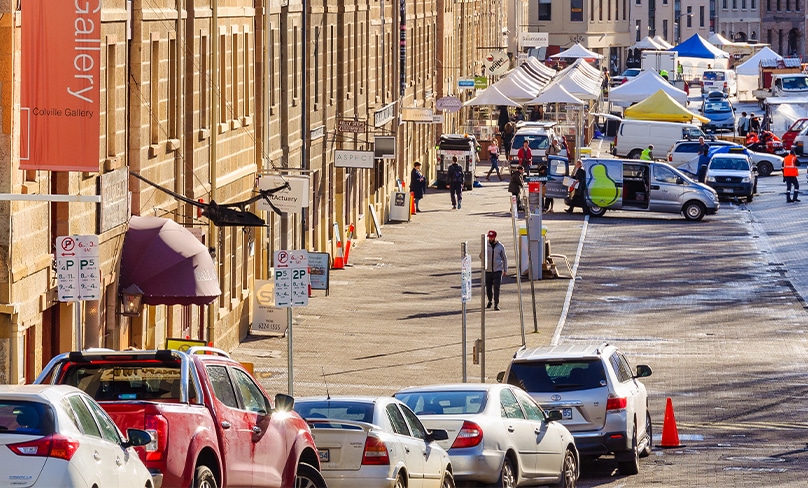
By Benedict Smith
Key figures in the establishment of the Catholic faith in Sydney did not restrict their work to NSW
During a recent five-year stint in Hobart, I discovered that long before the famous Sydney to Hobart boat race, key pioneering figures played pivotal roles in the development of civil society and the Catholic Church in the two cities.
The convict surveyor whose expert opinion guided the choice for Hobart’s location in 1804 was James Meehan, an Irish born Catholic. Meehan was subsequently appointed Deputy Surveyor of Lands by Governor Macquarie. During a trip to Van Diemen’s Land in 1811 Meehan mapped out the location of the streets of Hobart that has changed very little in over 200 years.
Later in 1820, he chose the site for St Mary’s Cathedral and became a founding member of the committee for the construction of the first Cathedral. He was also a generous contributor to the building fund. His dual city legacy is evident by the naming of the Meehan Ranges on the east side of Greater Hobart and James Meehan High School at Macquarie Fields in South West Sydney.
A close collaborator with Meehan who also had an impact on the two cities was Fr John Therry. After eighteen years of toil in NSW founding many churches and schools, Fr John Therry was appointed the Vicar General of Van Diemen’s Land in 1838. He soon initiated the construction of three churches. He secured partial Government funding for two of these churches but not for the building of St Joseph’s Church in Hobart. St Joseph’s Hobart was completed first, but its construction incurred a debt of £3300 that was owed by Fr Therry and the other trustees.
In 1843 the first Bishop of the Diocese of Hobart, Robert Willson, arrived in Hobart and the outstanding debt became a major point of division between the two men. Willson wanted the title deed, but Therry would not part with the deed until Willson took responsibility for the debt. The dispute dragged on for 14 years and became a major source of anxiety for Therry who became an ecclesiastical outcast. He travelled back to Sydney in 1854 never to return to Hobart. In 1856 he was appointed as the parish priest of St Augustine’s, Balmain where he remained until his death until in 1864. Therry’s pioneering work was closely followed by Mother Mary Aikenhead, the foundress of the Sisters of Charity. She personally equipped and trained five sisters to follow his path in the colonies.
“In recent times, the ecclesiastical connection between the two cities has been renewed as result of the Sydney based Bishop Julian Porteous being installed as the Archbishop of Hobart in September 2013.”
In 1838 Sister Xavier Williams arrived in Sydney with four other Sisters of Charity. They were the first religious sisters in the colony. Their first ministry was at the Parramatta Female Factory. In 1839, Sr Xavier became the first female in the colony to profess her vows. A few years later in 1847, after a falling out with Archbishop Polding, she travelled to Hobart with two other Sister to begin a separate branch of the Congregation under the authority of Bishop Willson.
On arrival they began a ministry at the Cascades Female Factory and soon after they were running St Joseph’s School in Hobart. Sister Xavier became the first female religious Principal of the school. In 1871 she became the Tasmanian Mother Superior. She also established St Joseph’s Orphanage in 1879 after the Government closed the state-run orphanage. Her last major achievement was the reforging the Congregational ties between Hobart and Sydney. Excerpts obtained from the Congregational Archives of the Sisters of Charity of Australia reveal some of the details behind how this happened.
During her Golden Jubilee celebrations in 1889, Mother Xavier was able to secure the help of the visiting Cardinal Moran in assisting with the amalgamation. After much ecclesiastical discourse and a visit by the Mother Superior of the Sydney branch to Hobart, the amalgamation was secured in June 1890.
The amalgamation ensured the Tasmanian branch got access to extra financial resources and new sisters for their continuing mission. Mother Xavier died on March 8, 1892 at the age of 91 and she was buried in Cornelian Bay Cemetery. The names of Mother Xavier and her two pioneering companions are etched onto the base of one of the Footsteps Towards Freedom statues located at Franklin Wharf in Hobart to commemorate the plight of female convicts and their children.
In recent times, the ecclesiastical connection between the two cities has been renewed as result of the Sydney based Bishop Julian Porteous being installed as the Archbishop of Hobart in September 2013. Soon after, the Sisters of the Immaculata arrived in Tasmania from Sydney to conduct their ministry until 2021. These two significant developments have helped to renew the Church in Tasmania.
Archbishop Porteous’ pastoral activities and the formation offered by the Sisters have also attracted many pilgrims from Sydney and elsewhere who have shared the spiritual benefits of their formation on their return. It is good to see history repeated.
Benedict Smith is the Head of Mission, Identity and Civics at Catholic Schools NSW
